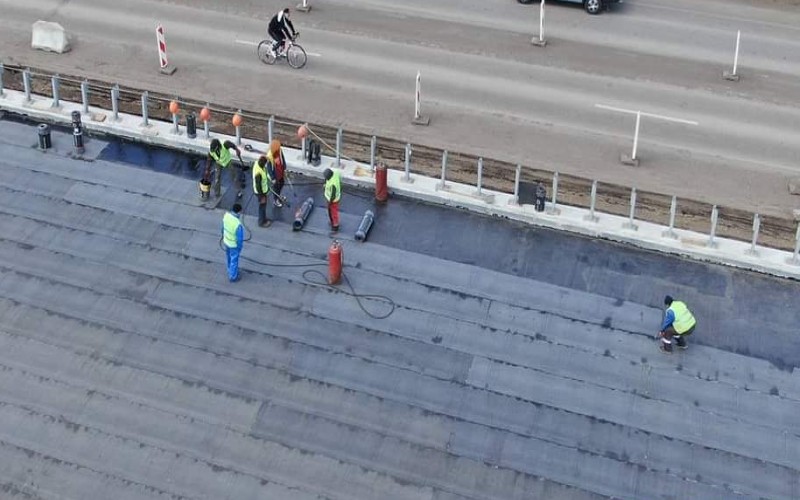Bridge waterproofing
Trestle waterproofing
Waterproofing of overpasses
Asphalt bridge waterproofing
Waterproofing materials for bridge structures
Why waterproof bridges?
The answer is obvious, in order to extend the life of bridge structures and protect the bridge from destruction.
Some would say that the asphalt pavement and the bituminous emulsion that is poured before the asphalt mix creates a waterproof coating for the structure of a bridge or crossing, perhaps so.
Unfortunately, after a couple of years, cracks will begin to appear on the asphalt, and the drainage system will not be able to cope with the removal of rainwater from the road surface.
Moisture begins to penetrate under the asphalt.

Cracking on the bridge
Also, it can be observed that during the operation of the overpasses, the interface zone of the expansion joint with asphalt, if it was foreseen to install the expansion joint at all, begins to collapse.
Water very quickly finds weak spots in the bridge pavement and penetrates into the concrete.

Destruction of asphalt along the expansion joint on the bridge
What needs to be protected and waterproofed on a bridge or overpass?
After the repair or installation of a new concrete base, when the contractors enter the finish line and are ready to lay the asphalt concrete or cement concrete pavement, it is then that waterproofing is applied under the asphalt or concrete slab.
Waterproofing of an overpass or bridge under asphalt must have high characteristics in terms of temperature resistance, elasticity and strength.
The temperature resistance of the waterproofing coating must be higher than the temperature of the asphalt.
When laying asphalt, the protective coating must not melt and become unusable. If the asphalt can burn through the waterproofing layer, then this is already a defect that will reduce the water resistance of the bridge structure.
Accordingly, you get a promising place for moisture leakage into the body of the concrete structure of the structure.
What happens if water gets under asphalt or waterproofing?

Destruction of span structures of the bridge
The concrete will absorb moisture
-
In winter, moisture from a liquid state, crystallizes into ice, into a solid state. There is an expansion of micropores in concrete.
-
With warming, the ice turns into a liquid state, and micropores and microcracks in concrete increase in size with each “freeze and thaw” cycle. Concrete loses its compressive and flexural strength and turns, over time, into "dust".
-
In our climate, there are a large number of such cycles in one season. Accordingly, every year, during the operation of transport facilities in such conditions, the bearing capacity of bridges and columns decreases, which is fraught with failure of the engineering structure.
- This leads not only to financial costs for the repair of the bridge or the inconvenience of drivers when crossing the reconstruction object. First of all, it is the safety and life of people.
As we can see, the fall of bridges is happening everywhere, not only in Ukraine, but all over the world.

The destruction of the bridge structure
Rebar corrosion
-
Upon contact with water, metal fittings begin to corrode. Metal microparticles break off from the reinforcement, which contributes to the expansion of concrete and the appearance of microcracks. The presence of cracks in concrete allows moisture to freely penetrate into the body of the structure, and accelerate the process of destruction of the concrete elements of the bridge structure.
- Also, the reinforcement itself decreases in diameter, thereby reducing the physical and mechanical characteristics of the object.

Corrosion of reinforcement in bridge beams
Penetration of an aggressive environment into concrete
The appearance of cracks in concrete accelerates the penetration of an aggressive environment, together with water and air, into the bridge structure. Rain water, melt water with salts, liquid petroleum products. All these elements worsen the condition of concrete and reinforcement.
What materials are used to waterproof bridges?
Basically, bitumen-polymer roll membranes, liquid rubber or sprayed bitumen-emulsion mastic, polyuria, it is polyurea and other hybrid types of polymer resins are used.
Basic requirements for bridge waterproofing materials
-
Seamless.
-
Temperature resistance.
-
Elasticity.
-
Strength.
-
High adhesion to the base.
-
Stable coating thickness.
Asphalt bridge waterproofing
Bitumen-polymer roll membranes
One of the materials that are economical and familiar to customers is specialized built-up bituminous membranes or, in the old fashioned way, "Ruberoid".
This type of waterproofing for superstructures of an overpass or bridge should not be confused with roofing materials.
Rolled waterproofing for the bridge has other physical and mechanical characteristics.
Built-up, hot method roofing material, can be used for concrete and metal bases.
Well-Known Brands of Bituminous Fused Membrane
-
Technoelast-Most.
-
Bmi Icopal Supermost / Icopal Bridge.
-
Rubiteks-Most.
-
Sika Ergobit etc.
- Icopal supermost.
Rolled waterproofing of the bridge under asphalt
The main characteristics of bitumen-roll waterproofing for the bridge
-
High heat resistance: 140-240 degrees.
-
Thickness: from 5 mm.
- Elasticity.
Advantages of rolled waterproofing for transport facilities
-
Low price per m2.
-
Asphalt is laid almost simultaneously with the installation of the membrane.
Disadvantages of roll waterproofing for transport facilities
-
The presence of seams.
-
Medium elasticity.
-
Medium adhesion to the base.
-
A perfectly level foundation is required.
- Low labor productivity.

Installation of rolled waterproofing of the bridge in Ukraine
In bridge waterproofing, as in roof waterproofing, using rolled materials, you always get seams.
Seams are the weakest point in rolled waterproofing.
First of all, moisture enters under the waterproofing carpet, at the seams. Over time, the seams diverge, dry out, deform, which leads to the formation of holes and the penetration of moisture.
Liquid rubber for bridges | Bitumen-latex emulsion for overpass waterproofing
Two-component, one-component, elastic, latex bitumen-polymer emulsion.
Sprayed mastic for bridge waterproofing, applied to the concrete base using specialized equipment.
After polymerization, liquid rubber forms a monolithic, homogeneous, elastic, seamless waterproofing system.
Elastofalt Spraykote 90
Well-known brands of sprayed membrane
-
Dorflex.
-
Rapid Flex.
-
Masterseal 620.
-
Flexigum.
-
Ultrabridge.
-
Technoprom-Most.
-
Rubberflex 55.
- Brit etc.
Advantages of a sprayed bitumen membrane for transport facilities
-
Elasticity: more than 800%.
-
Seamless.
-
Temperature resistance.
-
High adhesion to the base.
-
Strength.
-
Maintainability.
-
High productivity: up to 1000 m2 per shift.
Disadvantages of sprayed bitumen membrane for transport facilities
-
The high cost of m2, relative to roll waterproofing.
-
Asphalt laying, 24 hours after application.
-
Requires specialized application equipment.
-
Qualified contractors required.
- Air temperature for application: from + 5 degrees.
Polyuria for bridges | Polyurea for bridge structures
Polyurea for bridge waterproofing is gaining popularity all over the world.
This type of sprayed waterproofing for artificial engineering structures can be called high-tech today, as it has very high physical, mechanical and chemical characteristics.
Well-known brands of polyurea for waterproofing transport structures
-
MasterSeal M 800.
-
Whitechem.
-
Huntsman.
-
Duayen.
- Sika and others
Bridge waterproofing with polyurea
Benefits of polyurea for waterproofing transport structures
-
High degree of adhesion to the base.
-
High work performance.
-
Elasticity.
-
Strength.
-
Wear resistance.
-
Chemical resistance.
-
Fast curing: up to 60 sec.
- Diverse color range.
Polyurea waterproofing bridges
Disadvantages of polyurea for waterproofing transport facilities
-
High price, relative to a rolled bitumen membrane.
-
Requires specialized, expensive equipment.
- Professional contractors needed.
Conclusion
It is extremely necessary and mandatory to carry out waterproofing of transport artificial structures.
The choice of technologies allows you to choose different options, regarding your budget, terms of reference or project.
But the use of innovative waterproofing technologies provides many advantages for your business over competitors at presentations, as well as a unique opportunity to participate in complex, but high-margin projects.








